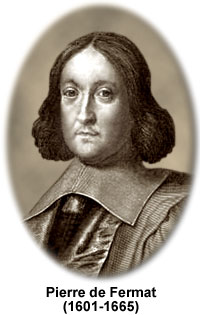Pierre de Fermat
(1601-1665)

Pierre de Fermat was a lawyer by occupation, but possessed one of the greatest mathematical minds of the seventeenth century. He made major contributions to geometric optics, modern number theory, probability theory, analytic geometry, and is generally considered the father of differential calculus. Though there is some doubt as to the date of his birth, Fermat was baptized on August 20, 1601 in Beaumont-de-Lomagne, France. His father was a successful merchant and his mother hailed from a well-to-do family. Fermat most likely received his primary education from a local Franciscan monastery and later studied at the University of Toulouse.
Fermat moved to Bordeaux, France for a few years in the 1620s, where he undertook an informal study of mathematics, but ultimately settled on law as a profession, receiving his Bachelors degree in Civil Law from the University of Orleans. In 1631, Fermat formally entered the legal profession, serving in the local Parliament at Toulouse. That same year he married his fourth cousin, Louise de Long, with whom he would later have five children. Over time, Fermat gradually attained legal positions with increasing responsibility and prestige, becoming a member of the criminal court in 1638 and a King's councilor in 1648, a post he retained for the rest of his life.
In addition to his professional duties, Fermat carried on an extensive correspondence with a number of prominent Parisian mathematicians, sometimes proposing analytical problems to them that he had already solved. Some of his earliest work examined the experiments of Galileo and the paths of freefalling objects. During his efforts to disprove several of the postulates made by Galileo, Fermat developed a new method of quadrature for curves. Then, when attempting to explain his techniques to his correspondents, he laid down the fundamental ideas of differential calculus in a paper entitled the "Method for Determining Maxima and Minima and Tangents to Curves Lines."
Though brilliant, Fermat was often at odds with other mathematicians, most notably René Descartes. The two almost simultaneously developed the principles of analytical geometry, and a dispute of priority ensued. Though Fermat prevailed, many members of the Paris group remained disgruntled due to his partial submittal of work and his competitive approach. From his reluctance to publish, Fermat would suffer similar criticism throughout his life and never achieved the notoriety he deserved. His work, primarily circulated in letter and manuscript format, often did not fully reveal his methods and proofs.
Fermat also differed from Descartes in his views on optics. In 1637, Descartes published "Dioptrics" as an appendix to his Discourse on Method. Within the work he examined the law of refraction, claiming that light travels faster in the denser of the two mediums involved. Many years later, Fermat noticed that the claim was contradictory to the Aristotelian notion that in nature, the shortest path is always taken. Thus, with this idea in mind and through the use of his method for determining minima and maxima, Fermat established what is usually described as the principle of least time in 1658. According to the tenet, a beam of light traveling between two points will follow the path that takes the shortest amount of time to complete. From the principle of least time, the law of refraction and the law of reflection could be deduced. Future scientists, however, demonstrated that Fermat's principle was incomplete or only partially true. In reality, a beam of light may also follow a trajectory of maximum duration.
The health of Fermat suffered in greatly in his later years, due to a bout with the plague in 1651. He cut off correspondence with other members of the scientific community periodically, though he carried on his own studies. By 1662, his mathematical communications ended altogether and he died on January 12, 1665. Subsequently, Fermat's eldest son, Clement-Samuel, assembled what he could find of his father's work for publication. In the margin of a Latin translation of Diophantus of Alexandria's Arithmetic, Clement-Samuel found what is known as Fermat's last theorem, which would also serve as the great mathematician's final challenge to other mathematicians. A brief note explained that he had discovered a remarkable proof of the complex theorem that was too long to fit in the margin, but the proof was never found. For more than three centuries, mathematicians attempted to develop their own proof of the theory, but the first to truly succeed was Andrew J. Wiles in 1994.
